
Key Takeaways
- Cardamom offers significant digestive benefits, making it an effective natural remedy for indigestion, bloating, and nausea.
- Both green and black cardamom varieties offer unique flavors and health properties—green is sweeter for desserts while black adds smoky depth to savory dishes.
- Regular consumption of cardamom may help regulate blood pressure through its potent antioxidant compounds.
- Proper storage in airtight containers away from heat and light can preserve cardamom’s essential oils and potency for up to a year.
- Beyond traditional chai, cardamom can transform everyday beverages and dishes with just a small amount, offering both flavor complexity and wellness benefits.
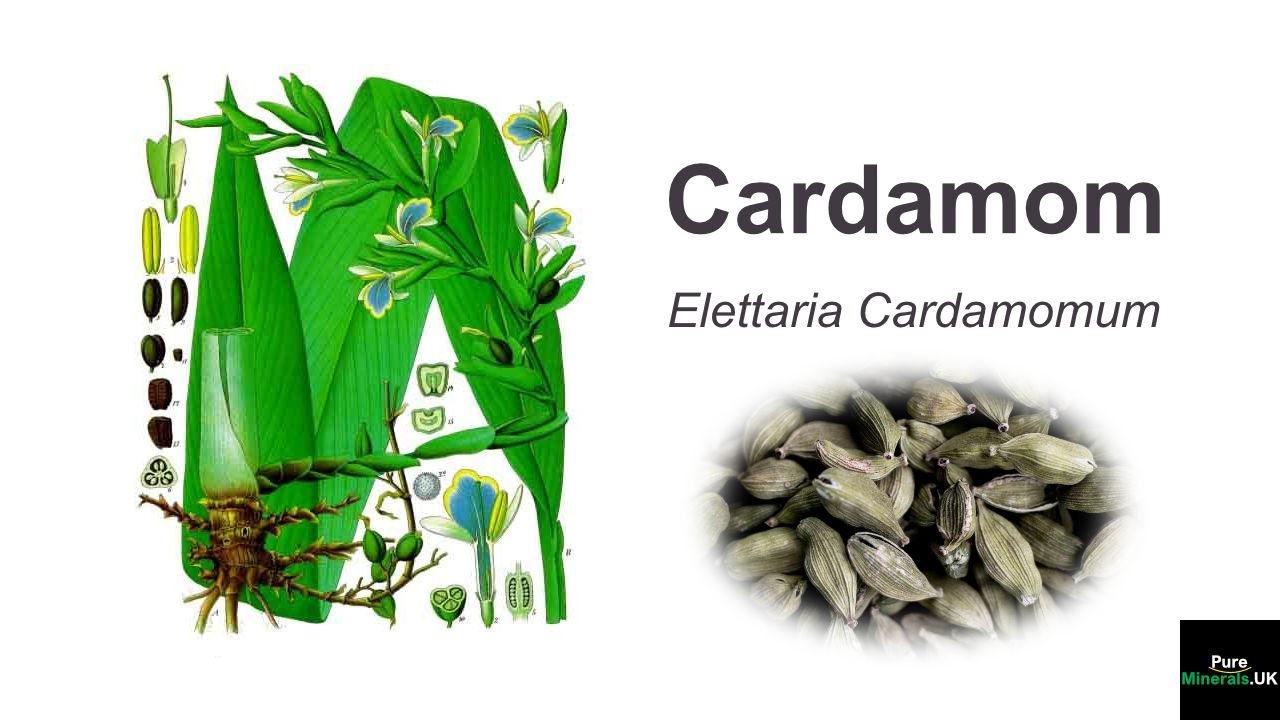
Updated on November 1, 2025, to include expanded information on Cardamom’s culinary uses and nutritional composition.
Cardamom does more than enhance your food’s flavor—it transforms your health from the inside out. This aromatic spice has been revered for thousands of years in traditional medicine systems for its remarkable therapeutic properties.
In kitchens across the world, from Indian curries to Scandinavian pastries, cardamom adds depth and complexity that few other spices can match. As natural remedy educators at the Natural Remedies Education Center have discovered through extensive research, the benefits of this spice extend far beyond its enticing aroma, offering digestive support, anti-inflammatory properties, and even potential cardiovascular benefits.
Whether you’re a culinary enthusiast looking to elevate your cooking or someone seeking gentle, effective natural remedies, cardamom deserves a permanent place in your spice cabinet. Let’s unlock the secrets of this queen of spices together.
Unlock the Queen of Spices: Why Cardamom Belongs in Your Kitchen
Often called the “Queen of Spices,” cardamom has earned its royal title through its complex flavor profile and remarkable versatility in the kitchen. This ancient spice belongs to the ginger family and has been treasured for over 4,000 years, originating in the lush mountains of southern India before spreading throughout Asia, the Middle East, and eventually to Europe and the Americas. Its distinctive taste—simultaneously sweet, floral, spicy, and citrusy—makes it uniquely capable of enhancing both savory and sweet dishes.
What truly sets cardamom apart is its dual identity as both culinary star and medicinal powerhouse. Unlike many spices that offer either flavor or health benefits, cardamom delivers both in abundance. The essential oils in cardamom pods contain compounds like cineole, terpinene, and limonene that contribute not only to its signature aroma but also to its impressive array of health-promoting properties. When you cook with cardamom, you’re not just seasoning food—you’re infusing it with centuries of traditional wellness wisdom.
Most impressively, cardamom adapts beautifully to nearly any culinary application. Whether steeped whole in simmering liquids, ground into powders for baking, or crushed slightly to release its aromatics in rice dishes, this adaptable spice works harmoniously with other ingredients without overwhelming them. This remarkable versatility explains why cardamom remains a staple in diverse culinary traditions—from Indian garam masala to Nordic cinnamon buns, and from Middle Eastern coffee to North African tagines. For more insights, check out the health benefits of cardamom.
The Different Types of Cardamom and How to Choose the Best
Understanding the distinct varieties of cardamom is essential for unlocking its full potential in both culinary applications and health remedies. Though they share a family resemblance, each type offers unique characteristics that make them suited for different purposes in your kitchen and wellness routine.
Green Cardamom: Sweet and Aromatic
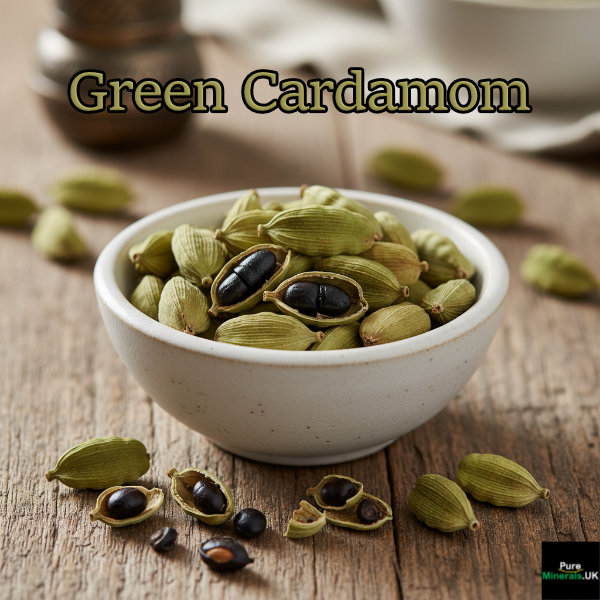
Green cardamom (Elettaria cardamomum) reigns as the most common and versatile variety, prized for its complex, sweet-spicy flavor profile with notes of eucalyptus and mint. These small, light green pods contain tiny black seeds that hold most of the essential oils responsible for cardamom’s distinctive aroma and therapeutic properties. When selecting green cardamom, look for pods that feel firm and heavy for their size, with a bright green color and strong fragrance when lightly crushed between your fingers.
This variety shines in both sweet and savory applications, making it indispensable in kitchens worldwide. In Scandinavian baking, it adds depth to pastries and breads; in Indian cuisine, it forms the backbone of garam masala and chai; and in Middle Eastern cooking, it perfumes rice dishes and coffee. For medicinal purposes, green cardamom is particularly valued for its digestive benefits and breath-freshening properties.
When cooking with green cardamom, remember that a little goes a long way—its flavor intensifies during cooking and can easily overpower other ingredients if used too liberally. One to three pods is usually sufficient for a four-serving dish, allowing its complex character to enhance rather than dominate your creation. For more on how to use cardamom effectively, check out this guide to cardamom in the kitchen.
Black Cardamom: Smoky and Bold

Black cardamom (Amomum subulatum) offers a dramatically different flavor profile with its intensely smoky, camphor-like taste. These larger, dark brown to black pods are dried over an open fire, which imparts their characteristic smokiness. Unlike its green cousin, black cardamom works almost exclusively in savory dishes, particularly slow-cooked meats, hearty stews, and robust curries, where its powerful presence can properly develop.
From a health perspective, black cardamom is especially noted for its respiratory benefits and potent antibacterial properties. In traditional medicine systems, it’s often prescribed for chest congestion, coughs, and digestive discomfort. When selecting black cardamom, choose pods that feel weighty with seeds that rattle slightly when shaken, indicating they’re full and well-developed.
White Cardamom: Bleached but Useful
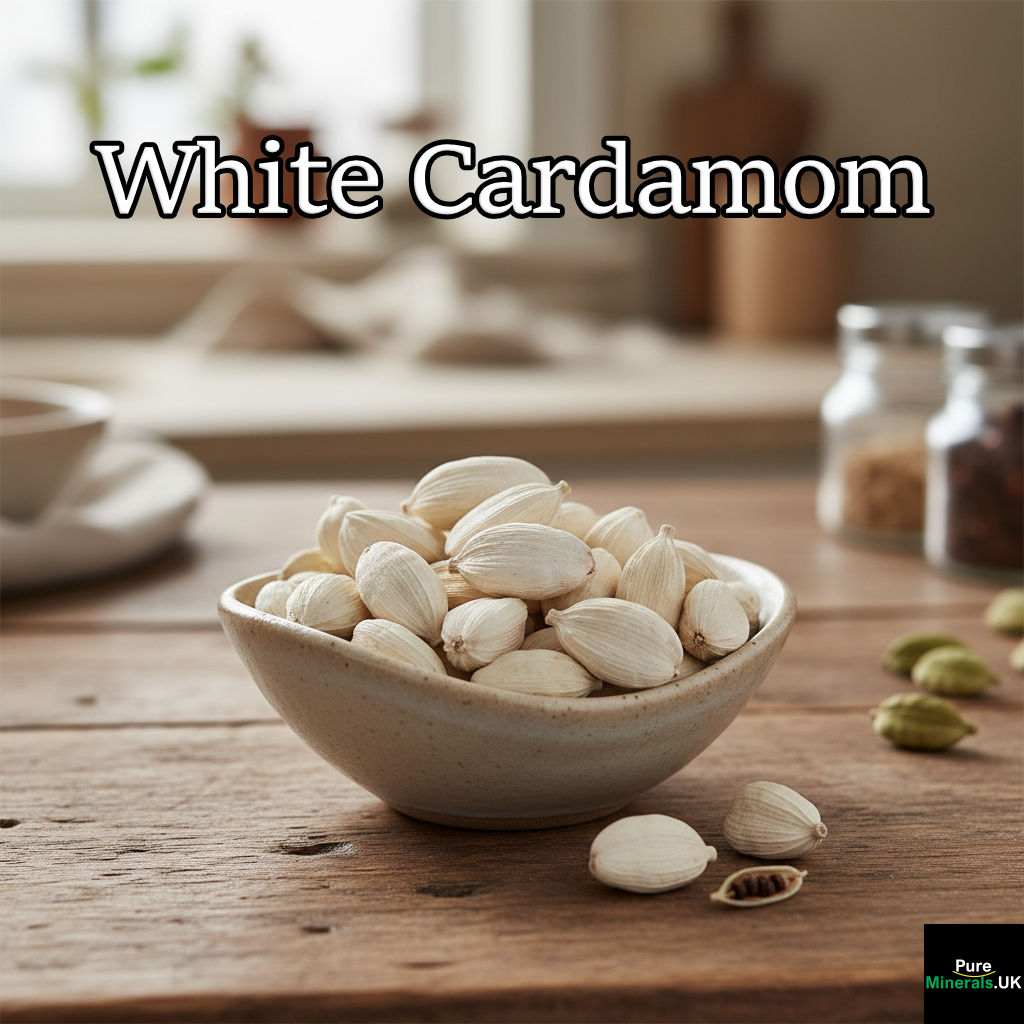
White cardamom is actually green cardamom that has been bleached, typically to create a more uniform appearance for certain applications. This process diminishes some of the essential oils, resulting in a milder flavor profile compared to its green counterpart. While not considered premium quality by purists, white cardamom can be useful in light-colored dishes where the appearance of green flecks would be undesirable. For more information on the benefits of cardamom, you can explore additional resources.
Though somewhat less potent in both taste and therapeutic properties, white cardamom still offers subtle aromatics that work well in delicate pastries, white sauces, and light desserts. If using white cardamom for health purposes, you may need to increase the quantity slightly to achieve similar benefits to green cardamom.
Ground vs. Whole Pods: Which to Use When
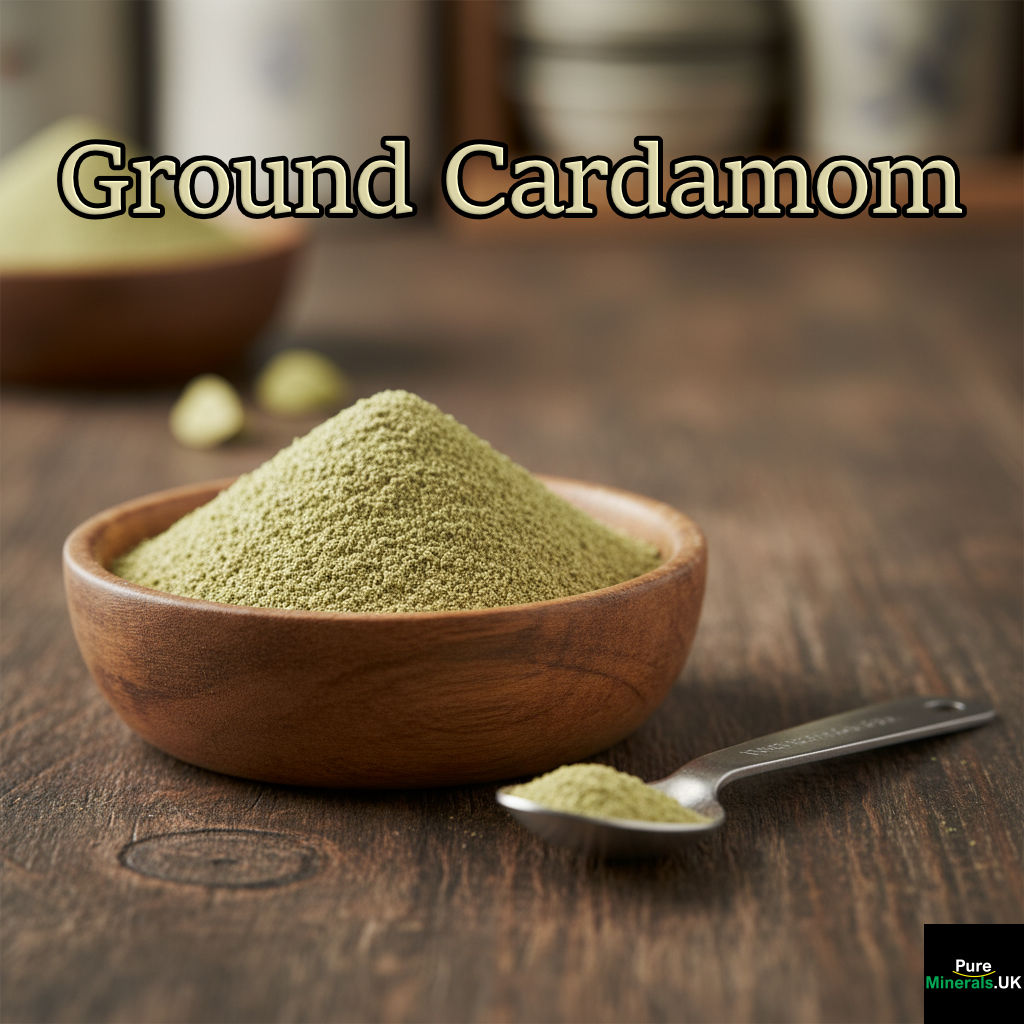
The decision between using ground cardamom or whole pods significantly impacts both flavor intensity and longevity in your culinary creations. Whole cardamom pods retain their essential oils and aromatic compounds far longer than pre-ground versions, making them the preferred choice for serious cooks and natural remedy practitioners. These intact pods keep their potency for up to a year when properly stored, allowing their complex flavor profile to fully develop in slow-cooked dishes.
Ground cardamom offers convenience but at a noticeable cost to flavor quality. Once the seeds are removed from their protective pods and ground, the volatile oils begin evaporating immediately, resulting in diminished potency and a flatter taste profile. If you must use ground cardamom, purchase it in small quantities from suppliers with high turnover, and replace it every three months for optimal freshness.
For the best of both worlds, consider grinding whole cardamom seeds just before use. Simply crack open the pods, remove the tiny black seeds, and grind them in a dedicated spice grinder or mortar and pestle. This fresh-ground approach delivers maximum flavor impact while allowing you to precisely control the texture—coarse for curries and stews, fine for baked goods and beverages.
5 Powerful Health Benefits of Cardamom
Beyond its captivating flavor, cardamom offers a treasure trove of evidence-backed health benefits that have been recognized in traditional medicine systems for centuries. Modern research continues to validate these traditional uses, revealing the biochemical mechanisms behind cardamom’s therapeutic effects. Incorporating this aromatic spice into your daily routine can support multiple aspects of your well-being through natural means. For more insights on its benefits, explore traditional medicine systems and their impact on health.
Natural Digestive Aid That Works Better Than Pills
Cardamom stands out as nature’s answer to digestive discomfort, often working more gently and effectively than commercial products. The essential oils in cardamom, particularly cineole and limonene, stimulate the production of digestive enzymes while simultaneously relaxing the smooth muscles of the gastrointestinal tract. This dual action helps alleviate common issues like bloating, gas, and stomach cramps without the side effects often associated with synthetic digestive aids.
For acute indigestion, chewing on a single cardamom pod after meals can provide immediate relief. For more chronic digestive issues, try incorporating cardamom into a daily tea—steep two lightly crushed pods in hot water for 10 minutes, then sip slowly. The carminative properties of cardamom make it particularly effective for dispelling excess gas, while its antispasmodic effects can help soothe irritable bowel symptoms.
Blood Pressure Management Through Antioxidants
Recent clinical studies have revealed cardamom’s potential as a natural approach to blood pressure regulation. The spice contains an impressive array of antioxidants that combat oxidative stress—a key factor in hypertension development. These compounds help relax blood vessels, improving circulation and potentially reducing both systolic and diastolic blood pressure readings over time.
In one 12-week clinical trial, participants who consumed 3 grams of cardamom powder daily showed significant improvements in their blood pressure measurements compared to the control group. While not a replacement for prescribed medications, cardamom may serve as a supportive natural remedy as part of a comprehensive approach to cardiovascular health. Its diuretic properties further contribute to blood pressure management by helping the body eliminate excess sodium and water retention.
Anti-Inflammatory Properties for Joint Pain Relief
Cardamom contains powerful anti-inflammatory compounds that can help alleviate joint pain and stiffness associated with arthritis and other inflammatory conditions. The active components in cardamom, including terpinene and cineole, work by inhibiting inflammatory pathways in the body similar to how many non-steroidal anti-inflammatory drugs (NSAIDs) function, but without the potential gastric side effects.
For those seeking natural relief from occasional joint discomfort, cardamom-infused oil offers a traditional remedy worth exploring. Gently warming a few tablespoons of coconut oil with 8-10 lightly crushed cardamom pods creates a soothing topical application that can be massaged into affected areas. When consumed regularly in foods and beverages, cardamom may also help reduce systemic inflammation, potentially addressing the root cause of joint pain rather than just masking symptoms.
Breath Freshener That Fights Oral Bacteria
Long before commercial mouthwashes, cardamom served as nature’s breath freshener across cultures. Its pleasant aroma instantly masks unpleasant odors, but cardamom goes beyond simple scent-masking—it actively fights the bacteria responsible for bad breath at their source. The antimicrobial compounds in cardamom, particularly cineole, have demonstrated effectiveness against common oral pathogens like Streptococcus mutans and Candida albicans.
Chewing on a single cardamom pod after meals not only freshens breath but also stimulates saliva production, which naturally cleanses the mouth and helps maintain optimal oral pH. For a more potent oral health boost, try brewing cardamom tea as a mouth rinse—the concentrated essential oils can reach areas between teeth and along the gum line where bacteria tend to accumulate. Regular cardamom consumption may even help prevent tooth decay and gum inflammation due to its antibacterial and anti-inflammatory properties.
Blood Sugar Regulation Support
Emerging research suggests cardamom may play a beneficial role in blood glucose management. The spice appears to enhance insulin sensitivity and improve glucose uptake in cells, potentially helping to maintain more stable blood sugar levels. For individuals concerned about metabolic health, cardamom offers a flavorful addition to a blood sugar-conscious diet.
Animal studies have shown that cardamom extract may help protect pancreatic beta cells—the cells responsible for insulin production—from oxidative damage. While human clinical trials are still in their early stages, these preliminary findings align with traditional uses of cardamom in Ayurvedic medicine for balancing blood sugar. For a potential metabolic boost, try adding a pod of cardamom to your morning coffee or tea, or incorporate ground cardamom into breakfast foods like oatmeal or smoothies.
Sweet Dishes That Shine With Cardamom
Cardamom’s complex sweet-spicy profile makes it an exceptional addition to desserts and sweet treats across culinary traditions. Its unique ability to enhance sweetness while adding sophisticated depth transforms ordinary baked goods into memorable delights. The sweet applications of cardamom demonstrate its remarkable versatility while delivering its health benefits in the most palatable forms.
Cardamom-Infused Baked Goods
Cardamom elevates baked goods from commonplace to extraordinary with its complex flavor notes that complement traditional baking spices. In Scandinavian baking, where cardamom has been embraced for centuries, the spice stars in beloved treats like kanelbullar (cinnamon rolls) and kardemummabullar (cardamom buns), where it creates a warm, aromatic foundation. For home bakers, incorporating freshly ground cardamom into cookie dough, cake batters, and quick bread recipes instantly adds sophistication and depth.
The key to successful cardamom baking lies in balancing its potent flavor with complementary ingredients. It pairs beautifully with citrus zests, vanilla, chocolate, and nuts—particularly pistachios and almonds. Try adding ½ to 1 teaspoon of freshly ground cardamom to your favorite sugar cookie recipe, or knead cardamom into sweet bread doughs for a subtle but distinctive flavor that will have everyone asking for your secret ingredient.
For a truly transformative experience, replace the cinnamon in your apple pie with cardamom, or combine both spices for a complex flavor profile that enhances the natural sweetness of the fruit while adding unexpected depth. The digestive benefits of cardamom make these sweet treats not just delicious but somewhat more body-friendly as well, potentially easing the discomfort sometimes associated with rich desserts.
Desserts From Around the World
Cardamom’s global culinary journey has resulted in a remarkable diversity of sweet applications that showcase its adaptability. In India, cardamom is essential to kheer (rice pudding) and gulab jamun, where it creates harmony with rose water and saffron. Middle Eastern desserts like baklava and halva rely on cardamom to balance their intense sweetness, while Scandinavian kitchens incorporate it into Christmas cookies and celebratory cakes.
The most striking aspect of these global traditions is how cardamom adapts to different sweeteners—complementing the deep notes of molasses and brown sugar in Western baking, harmonizing with honey in Mediterranean sweets, and enhancing the subtle sweetness of coconut milk in Southeast Asian desserts. This remarkable adaptability makes cardamom a valuable addition to virtually any sweet culinary tradition, allowing you to explore global flavors while benefiting from its digestive properties.
For an accessible introduction to international cardamom sweets, try making rice pudding with a simple ratio of 1 cup rice to 4 cups milk, sweetened with honey or maple syrup, and flavored with 3-4 cardamom pods. This gentle dessert showcases cardamom’s ability to transform basic ingredients while offering digestive comfort after meals.
1-Minute Cardamom Hot Chocolate Recipe
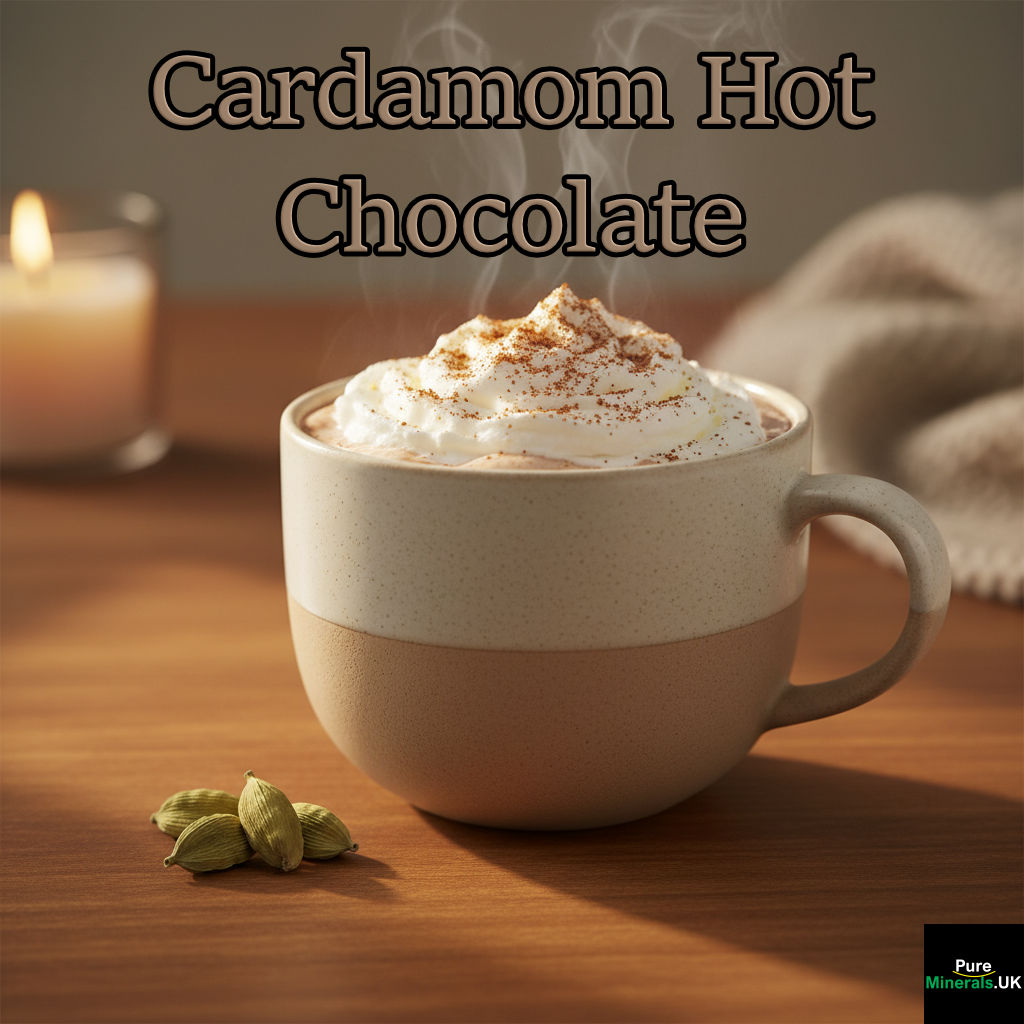
Transform ordinary hot chocolate into an extraordinary sensory experience with this simple yet sophisticated cardamom infusion. The warm, complex notes of cardamom perfectly complement chocolate’s richness while adding digestive benefits that help your body process the indulgent treat. Begin with high-quality dark chocolate (at least 70% cacao) for maximum flavor and antioxidant content.
To prepare this quick remedy, heat one cup of your preferred milk (dairy or plant-based) until steaming but not boiling. Add 1-2 tablespoons of dark chocolate pieces and ¼ teaspoon freshly ground cardamom. Whisk continuously until the chocolate melts completely, then add a touch of honey or maple syrup if desired. The result is a sophisticated beverage that soothes the digestive system while satisfying chocolate cravings—a perfect example of how cardamom transforms both flavor and function in simple preparations.
Savory Cooking Applications That Will Transform Your Meals
While cardamom shines in sweet applications, its true versatility becomes apparent when exploring its savory potential. Across Middle Eastern, Indian, and North African cuisines, cardamom serves as a cornerstone spice in countless savory dishes, adding depth and complexity while supporting the digestion of protein-rich meals. The following applications demonstrate how this queen of spices can elevate everyday cooking while delivering its therapeutic benefits.
Rice Dishes That Sing With Cardamom
Cardamom transforms ordinary rice into an aromatic delicacy that complements virtually any main course. The traditional preparation method involves adding 2-3 whole cardamom pods to the cooking water for each cup of rice, allowing the spice to gently infuse the grains as they absorb liquid. This simple technique creates a fragrant base for curries, stews, and grilled proteins while aiding the digestion of these sometimes heavy meals.
For special occasions, Persian jeweled rice showcases cardamom’s affinity for saffron, dried fruits, and nuts. This celebratory dish combines cardamom-scented basmati with vibrant ingredients that create a stunning visual presentation alongside complex flavor. Even a basic pilaf gains remarkable dimension when cardamom joins other whole spices like cinnamon sticks and cloves in the initial oil or ghee before adding rice. For more insights on the health benefits of spices, explore our Herbs List.
Beyond its flavor contributions, cardamom’s addition to rice dishes serves the practical purpose of improving digestibility and preventing the bloating sometimes associated with grain consumption. This functional aspect makes cardamom-infused rice particularly valuable for those with sensitive digestion or when serving meals to guests.
Meat and Poultry Pairings
Cardamom’s warming properties make it an excellent partner for meat and poultry dishes, particularly in slow-cooked preparations where its complex flavor has time to fully develop. In North African tagines, cardamom joins other warming spices to transform tough cuts of meat into tender, aromatic dishes. The spice’s natural tenderizing effect helps break down proteins while simultaneously enhancing flavor penetration.
For everyday cooking, try adding 2-3 crushed cardamom pods to marinades for chicken or lamb, particularly when yogurt serves as the base. The cardamom infuses the meat during marination while its enzymes begin the tenderizing process. When grilling or roasting, cardamom creates a sophisticated aroma that elevates simple proteins to restaurant-quality preparations.
From a health perspective, cardamom’s addition to meat dishes serves a crucial function beyond flavor enhancement. The spice’s carminative and digestive properties help the body process protein more efficiently, potentially reducing discomfort and bloating after consuming meat-heavy meals—another example of traditional wisdom validated by modern understanding of digestive processes.
Vegetable Dishes With a Twist
Cardamom brings unexpected sophistication to vegetable preparations, particularly root vegetables and winter squashes whose natural sweetness it enhances. Try roasting carrots, sweet potatoes, or butternut squash with olive oil, a touch of honey, and freshly ground cardamom for a side dish that balances sweet and savory notes perfectly. The spice’s warming properties complement the earthy flavors of these vegetables while supporting their digestion.
In vegetarian main courses, cardamom adds depth to legume-based dishes like lentil stews and chickpea curries. Its complex flavor profile helps overcome the blandness sometimes associated with plant proteins, while its digestive benefits address the bloating often experienced after consuming legumes. For a simple yet impressive dish, add whole cardamom pods to simmering lentils along with other aromatic vegetables for a nourishing one-pot meal.
Cardamom in Beverages: Beyond Chai Tea
While chai tea represents cardamom’s most recognized beverage application, this versatile spice enhances a remarkable range of drinks, both hot and cold. Cardamom’s ability to infuse liquids with its complex aroma makes it ideal for beverage applications, where it can deliver both flavor satisfaction and therapeutic benefits in a highly bioavailable form.
Coffee Enhancement Techniques
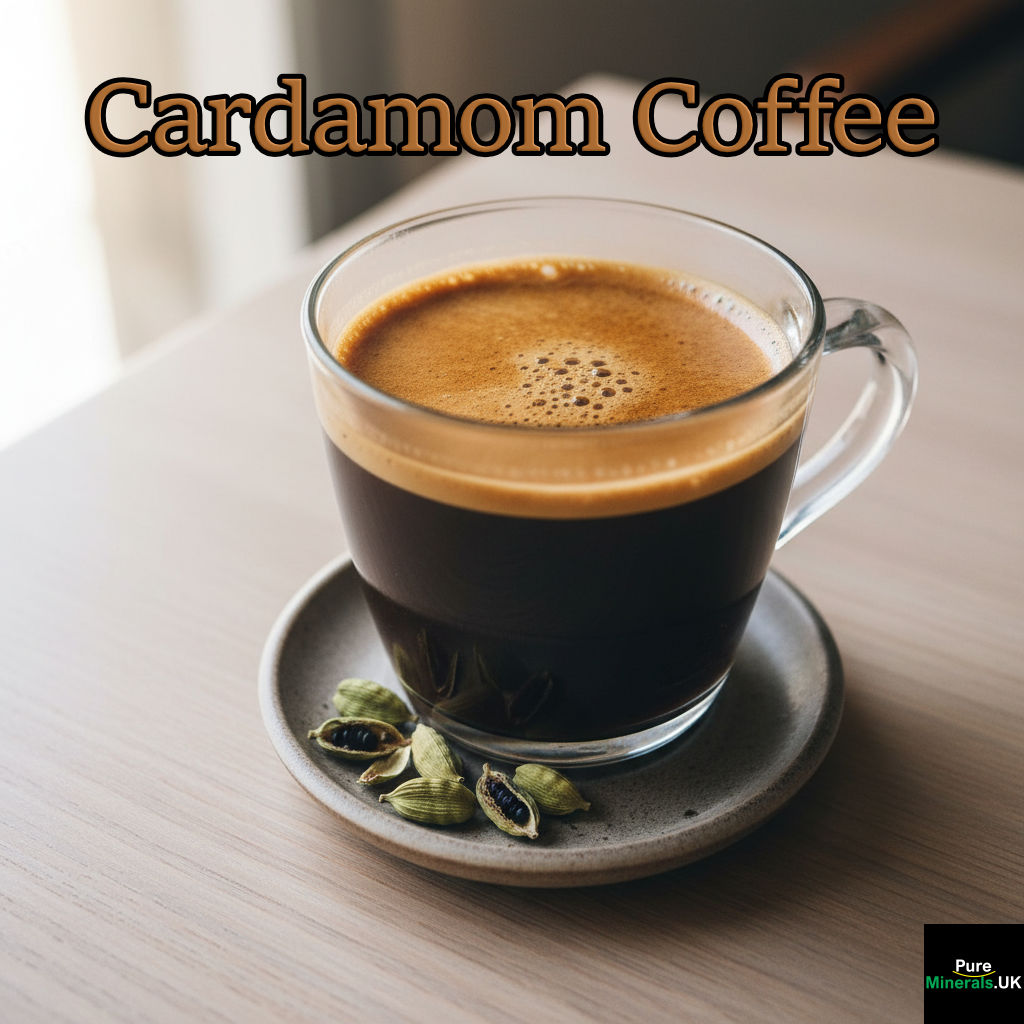
Across the Middle East, particularly in countries like Saudi Arabia, Lebanon, and Turkey, cardamom-infused coffee represents a centuries-old tradition that transforms ordinary coffee into an aromatic ritual. The simplest method involves adding a single crushed cardamom pod to ground coffee before brewing, allowing its essential oils to blend with the coffee’s natural compounds. This combination not only creates a distinctive flavor but also helps mitigate coffee’s potential acidity and digestive harshness.
For cold brew enthusiasts, adding 2-3 lightly crushed cardamom pods to the grounds before the long extraction creates a smooth, aromatic concentrate that works beautifully in both hot and iced applications. The slow extraction particularly favors cardamom’s complex flavor development, resulting in a sophisticated beverage that supports digestive health while providing caffeine’s energy boost.
From a wellness perspective, cardamom-infused coffee offers a strategic advantage—the spice helps balance coffee’s stimulating effects while supporting the digestion of accompanying breakfast foods. This natural synergy explains why the combination has endured across cultures despite evolving coffee trends. For more insights on the benefits of spices, explore the root of all disease.
Herbal Teas and Infusions

Beyond the familiar chai, cardamom shines in simple herbal infusions that highlight its therapeutic properties. A basic cardamom tea—made by simmering 3-4 lightly crushed pods in water for 5-10 minutes—serves as an effective digestive remedy after heavy meals or for occasional stomach discomfort. This simple preparation delivers cardamom’s beneficial compounds in their most direct form.
For respiratory support, particularly during cold and flu season, combine cardamom with ginger and honey in hot water. This traditional remedy addresses congestion while soothing throat irritation and supporting immune function. The antimicrobial properties of cardamom may help fight respiratory infections while its aromatic compounds assist in clearing congested airways.
Cardamom in Cocktails and Mocktails
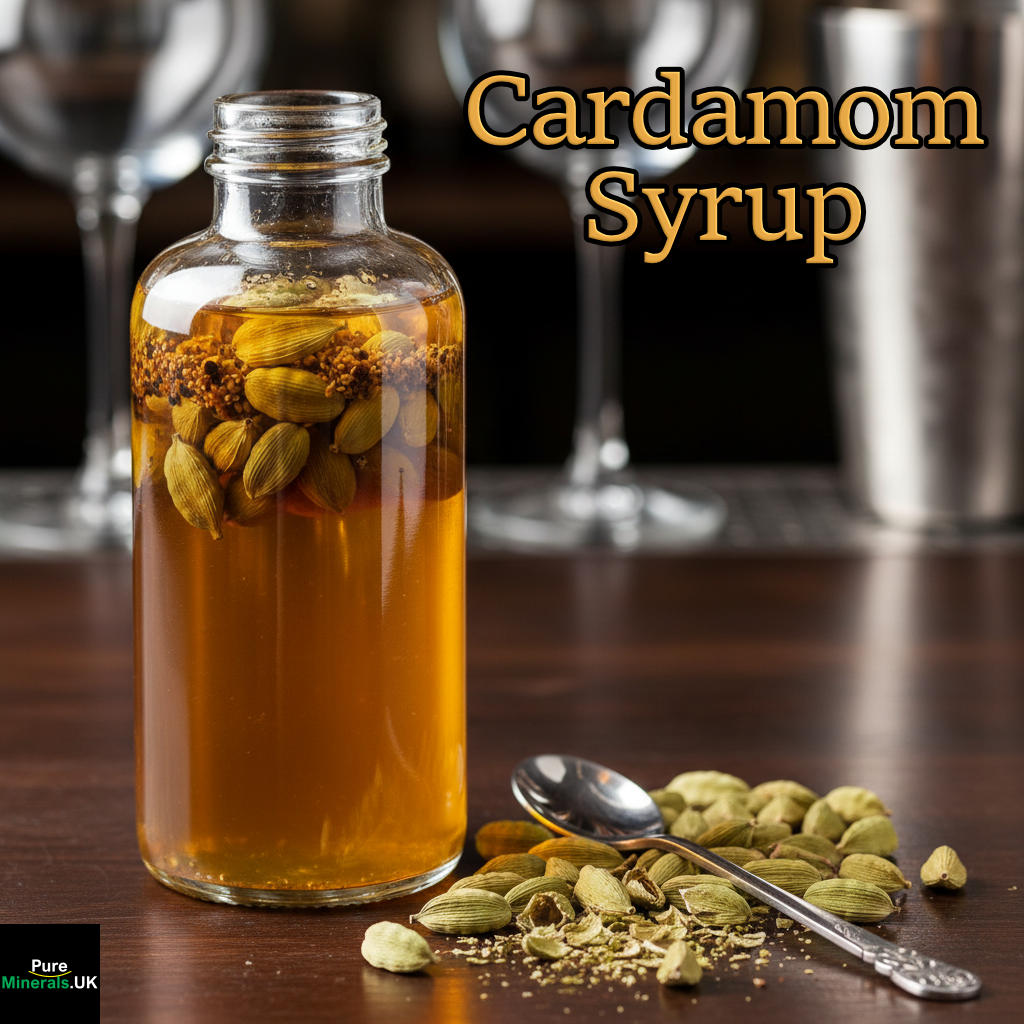
Innovative mixologists have embraced cardamom’s complex profile in creating sophisticated cocktails and alcohol-free alternatives. Cardamom syrup—made by simmering crushed pods in simple syrup—adds depth to both spirit-based drinks and mocktails, particularly those featuring citrus or apple notes. The spice’s warming quality balances cold beverages while adding aromatic complexity that engages multiple senses.
For a simple yet impressive cardamom-infused beverage, try muddling a cardamom pod with fresh lime and mixing it with sparkling water and a touch of honey. This refreshing mocktail offers digestive benefits while providing a sophisticated non-alcoholic option for social occasions. The combination of cardamom’s therapeutic properties with hydration makes such beverages functional as well as flavorful. To explore more about the therapeutic properties of cardamom, you can read Chapter 13 of The Root of All Disease.
Top 7 Cardamom Cooking Techniques for Maximum Flavor
Mastering cardamom’s preparation and incorporation techniques allows you to extract maximum flavor and health benefits from this precious spice. These methods, refined over centuries of culinary tradition, ensure that cardamom’s essential oils and bioactive compounds fully express themselves in your cooking. Each technique serves specific culinary purposes while preserving cardamom’s therapeutic potential.
1. Toasting to Release Oils
Briefly toasting whole cardamom pods in a dry skillet over medium-low heat represents one of the most effective ways to amplify their flavor before incorporation into recipes. This gentle heat causes the essential oils to become more volatile, intensifying both aroma and taste while making the beneficial compounds more bioavailable. The process takes just 1-2 minutes—watch carefully for the pods to become fragrant but not burned, as excessive heat can create bitterness.
This technique works particularly well when cardamom will be used in dishes with shorter cooking times, like quick stir-fries or sautés, where the spice would otherwise have limited opportunity to release its full character. After toasting, you can use the pods whole, crack them slightly, or grind them depending on your recipe’s requirements.
2. Grinding Just Before Use
The volatile oils in cardamom begin dissipating immediately after grinding, making fresh grinding a crucial technique for maximum flavor impact. Invest in a dedicated spice grinder or mortar and pestle to process only the quantity needed for immediate use. First, crack the pods to extract the small black seeds inside, then grind only these seeds to your desired consistency—from coarse for textural interest to fine powder for smooth incorporation. For more on cardamom’s culinary uses and benefits, check out this comprehensive guide on cardamom.
This just-in-time approach ensures you experience cardamom’s complete flavor profile and full therapeutic potential, particularly important when using the spice primarily for its health benefits. The difference between freshly ground cardamom and pre-ground powder is immediately apparent in both aroma and taste intensity, making this extra step worthwhile for serious cooks and health enthusiasts.
3. Pod-Splitting Method
When using whole cardamom pods in liquid-based recipes like soups, stews, and braises, the pod-splitting method enhances flavor extraction while maintaining visual appeal. Simply press each pod with the flat side of a knife until it cracks slightly—this allows the flavorful seeds to remain contained within the pod while permitting cooking liquid to access them. The result is gradual flavor infusion without loose seeds floating in the finished dish.
This technique works beautifully in rice preparations, curries, and poaching liquids, where it creates aromatic depth while allowing for easy removal of the pods before serving. From a health perspective, the controlled splitting allows cardamom’s digestive compounds to infuse into the liquid while preserving the pods’ integrity for visual identification.
4. Infusing in Warm Liquids
Cardamom readily releases its flavor compounds in warm liquids, making infusion an ideal technique for beverages, sauces, and custards. For optimal results, lightly crush 2-3 pods before adding them to liquid that has been heated but not boiling—excessive heat can cause bitterness, while tepid liquid won’t extract effectively. Allow the pods to steep for 10-15 minutes, then strain if desired or leave the pods for continued flavor development.
This method creates particularly harmonious results in dairy-based preparations like ice cream bases, puddings, and cream sauces, where cardamom’s aromatics blend seamlessly with the fat content. The gentle extraction preserves cardamom’s more delicate flavor notes while drawing out its therapeutic compounds, making the infusion ideal for both culinary and medicinal applications.
5. Direct Pod Addition for Slow Cooking
In long-simmered dishes like stews, braises, and slow-cooked curries, adding whole cardamom pods directly to the cooking vessel allows for gradual flavor release that deepens over time. This technique works with cardamom’s natural properties rather than forcing immediate extraction, resulting in layered flavor development throughout the cooking process. The pods soften considerably during extended cooking, releasing both the seeds and the pods’ own flavor compounds.
When using this technique, consider the pod count carefully—2-3 pods adequately flavor most 4-serving recipes, while larger batches may require proportionally more. Remember to either remove the pods before serving or alert diners to their presence, as biting into a whole cardamom pod can provide an unexpectedly intense flavor burst.
6. Tempering in Oil (Tadka Method)
The tadka or tempering method—briefly frying whole spices in hot oil or ghee—represents one of the most effective techniques for extracting cardamom’s full flavor potential. This traditional Indian approach causes the essential oils to infuse into the fat, creating an aromatic base that distributes flavor throughout the finished dish. For best results, heat oil until shimmering but not smoking, add lightly crushed cardamom pods, and cook just until fragrant—usually 30-60 seconds.
This flavored oil can then form the foundation for countless dishes, from vegetables and legumes to meat and poultry preparations. Beyond flavor enhancement, the tadka method may increase the bioavailability of cardamom’s therapeutic compounds by binding them to fat molecules, potentially improving their absorption in the digestive system.
7. Cardamom Salt and Sugar Blends
Creating specialized cardamom-infused salt or sugar blends provides convenient ways to incorporate this spice’s benefits into everyday cooking without measuring individual amounts each time. For cardamom salt, combine 1 tablespoon freshly ground cardamom seeds with ¼ cup high-quality sea salt, then store in an airtight container. This aromatic salt elevates everything from roasted vegetables to grilled meats with a single sprinkle.
Similarly, cardamom sugar—made by blending 1 tablespoon ground cardamom with 1 cup raw sugar and allowing it to infuse for several days—creates an instant flavoring for coffee, tea, baked goods, and fruit preparations. These blends allow you to incorporate cardamom’s health benefits into multiple daily meals with minimal effort, making them practical tools for consistent use of this therapeutic spice.
Storage Secrets for Maximum Potency and Shelf Life
Proper storage of cardamom significantly impacts both its flavor potency and therapeutic value over time. The volatile essential oils responsible for cardamom’s distinctive aroma and health benefits degrade when exposed to environmental factors like heat, light, and air. Implementing optimal storage practices ensures you receive maximum value from this premium spice while preserving its medicinal properties for when you need them.
Proper Container Selection
The ideal storage container for cardamom creates a complete barrier against air, light, and moisture—the three primary factors that accelerate essential oil deterioration. Opaque glass jars with airtight seals provide the best protection, allowing minimal oxygen exchange while blocking light completely. Avoid plastic containers, which can both absorb cardamom’s essential oils and leach their own compounds into the spice, potentially altering its therapeutic properties.
For whole cardamom pods, which retain freshness longer than ground cardamom, consider dedicated spice jars with double-sealed lids. The initial investment in proper storage containers pays dividends through extended spice viability and maintained medicinal potency.
Temperature and Light Considerations
Contrary to common practice, the spice cabinet above your stove represents one of the worst possible storage locations for cardamom and other volatile spices. Heat rises from cooking activities, creating temperature fluctuations that accelerate essential oil evaporation. Instead, store cardamom in a cool, dark cabinet away from heat sources and direct sunlight, where stable temperatures below 70°F (21°C) help preserve its aromatic compounds.
Refrigeration offers another viable storage option, particularly in humid climates where moisture represents a significant threat to spice integrity. If refrigerating cardamom, ensure it remains in an airtight container to prevent condensation upon removal, which could introduce damaging moisture to the spice. Allow refrigerated cardamom to reach room temperature before opening the container to further prevent condensation issues.
Freezing whole cardamom pods can extend their shelf life to nearly two years while preserving most of their aromatic properties—a practical option for those who use the spice occasionally rather than daily. When freezing, double-wrap the pods to prevent freezer odors from affecting their delicate flavor profile. For more insights on maintaining the quality of spices, you might find this chapter on preserving natural products useful.
Shelf Life Guidelines You Need to Know
Understanding cardamom’s expected viability timeframes helps you maximize both culinary satisfaction and therapeutic benefits. Properly stored whole cardamom pods retain optimal flavor and medicinal properties for approximately 12 months at room temperature, with minimal degradation during this period. The protective pod structure shields the seeds inside, preserving essential oils from evaporation and oxidation.
Ground cardamom begins losing potency immediately after processing, with significant degradation occurring within 3-4 months even under ideal storage conditions. This rapid deterioration explains why spice experts consistently recommend purchasing whole pods and grinding as needed—the flavor and therapeutic difference justifies the minimal additional effort required.
Cardamom Substitutes in a Pinch
While no single spice perfectly replicates cardamom’s unique profile, several alternatives can approximate its function in recipes when you find yourself without this prized ingredient. Understanding these substitutes’ strengths and limitations allows for successful recipe adaptation while maintaining flavor harmony. Remember that these alternatives may mimic cardamom’s taste but won’t provide its specific health benefits.
- Cinnamon and ginger (equal parts) – provides warming qualities with sweet undertones
- Allspice – offers similar complexity with clove-like notes
- Equal parts cinnamon, nutmeg, and clove – replicates cardamom’s warming complexity
- Cardamom extract (¼ teaspoon per pod) – concentrated flavor without texture
- Pink peppercorns – provide surprising floral notes with gentle heat
When substituting, start with approximately ¾ of the called-for amount of cardamom, then adjust according to your taste preferences. Remember that these alternatives may work better in some applications than others—cinnamon and ginger excel in sweet recipes, while allspice often performs better in savory contexts.
For the most convincing cardamom alternative in beverages like chai or coffee, combine equal parts ground cinnamon and ground ginger with a pinch of ground nutmeg. This blend approximates cardamom’s warming quality and aromatic complexity while complementing the other flavors typically found in these preparations.
Spice Combinations That Mimic Cardamom
Certain spice blends can create reasonable approximations of cardamom’s complex profile when the single-spice substitutes don’t quite satisfy. A particularly effective combination blends one part ground cinnamon, one part ground ginger, and one-quarter part ground nutmeg—this triumvirate captures cardamom’s warming qualities while providing aromatic complexity. This blend works especially well in baked goods and sweet preparations where cardamom would typically shine.
For savory applications, particularly Indian curries and rice dishes, try combining equal parts ground coriander and cumin with half the amount of freshly ground black pepper and a touch of lemon zest. While not replicating cardamom exactly, this combination provides the aromatic depth and slight citrus notes that cardamom would contribute to these dishes.
When creating these substitution blends, use freshly ground spices whenever possible for maximum flavor impact. The freshness factor becomes even more important when attempting to replicate a spice as nuanced as cardamom, where subtle aromatic notes make significant contributions to the overall flavor experience.
Single-Spice Alternatives
Among individual spices, allspice provides perhaps the closest single-ingredient substitute for cardamom, offering complex aromatic qualities with similar warmth. Though lacking cardamom’s distinctive eucalyptus notes, allspice contributes a compatible flavor that works in both sweet and savory applications. When substituting allspice for cardamom, use approximately three-quarters the amount called for in your recipe, as allspice can dominate more readily than cardamom. For more insights on cardamom, explore its health benefits.
Your Cardamom Journey Starts Now: Simple First Steps
Begin your exploration of cardamom’s culinary and therapeutic potential with these accessible entry points: add a single crushed pod to your morning coffee grounds before brewing; incorporate ¼ teaspoon freshly ground cardamom into pancake or waffle batter for weekend breakfast; or steep two pods in hot water for five minutes to create a simple digestive tea after dinner. These minimal-effort applications provide immediate experience with cardamom’s distinctive character while delivering gentle health benefits.
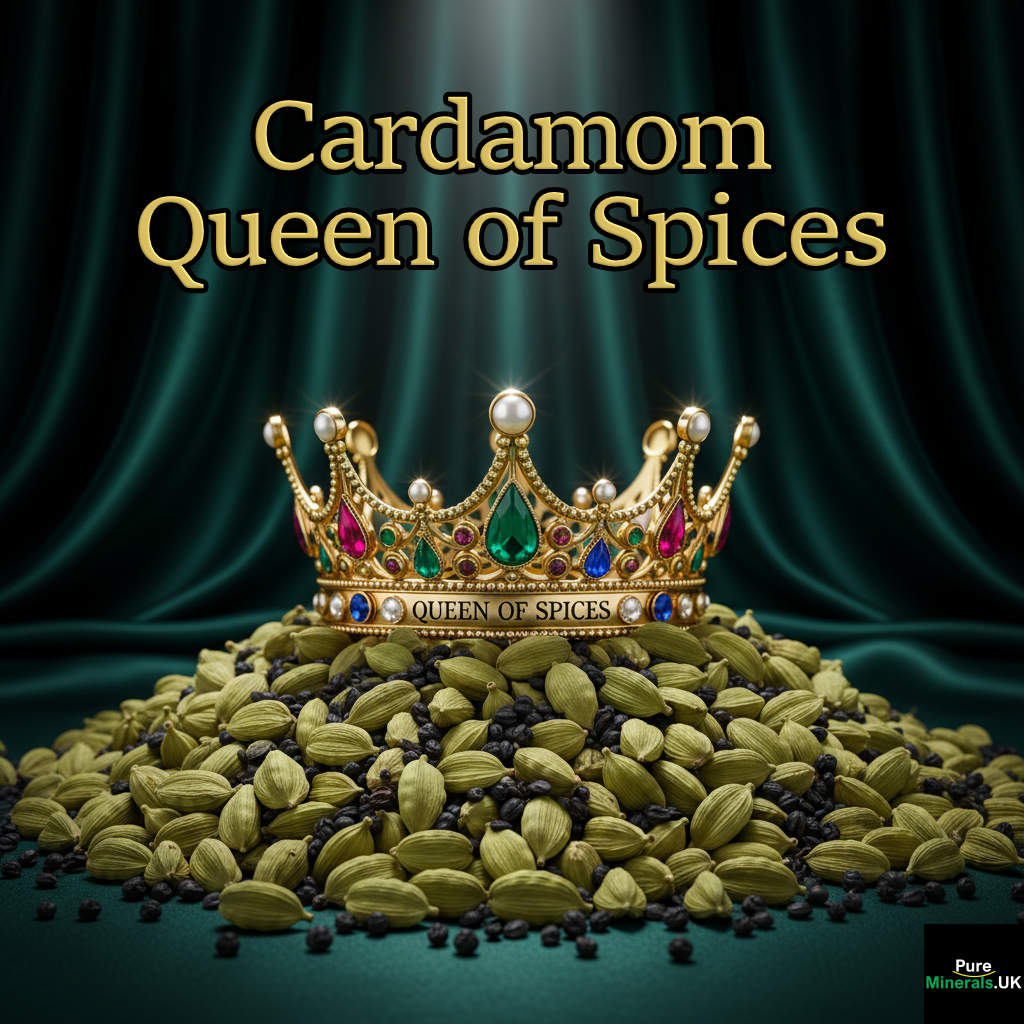
As your appreciation for this queen of spices grows, gradually expand your cardamom repertoire to include more complex applications like spice blends, baked goods, and savory dishes. Remember that cardamom’s true magic lies in both its flavor-enhancing capabilities and its therapeutic properties—embrace both aspects to fully appreciate why this ancient spice remains relevant in modern kitchens and natural medicine.
Ready to feel your absolute best? Unlock vibrant, natural energy and nourish every cell in your body with the power of our 16 essential vitamins and 74+ pure plant-derived minerals – much more than in cardamom. Discover the difference today – visit our shop page.
Frequently Asked Questions
As you incorporate cardamom into your cooking and wellness routines, certain questions frequently arise about its proper use, potential benefits, and possible concerns. The following answers provide evidence-based guidance while addressing common misconceptions about this versatile spice.
These practical insights will help you use cardamom confidently in diverse applications while understanding its therapeutic potential and limitations. Always consult healthcare providers about specific medical conditions before using any spice medicinally.
Is cardamom safe to consume daily?
Cardamom is generally recognized as safe for daily consumption in culinary amounts, typically defined as up to 1-2 pods or ¼ teaspoon ground cardamom per serving. At these levels, most individuals experience no adverse effects while potentially benefiting from cardamom’s digestive properties and antioxidant content. The spice’s long history of daily use in traditional diets across multiple cultures further supports its safety profile for regular consumption.
Those considering cardamom supplements or concentrated extracts should exercise greater caution and consult healthcare providers, as these formulations deliver substantially higher doses than culinary applications. Pregnant women should stick to food-based amounts rather than therapeutic doses, though moderate culinary use is generally considered safe during pregnancy and may actually help manage nausea.
What’s the difference between green and black cardamom in cooking?
Green and black cardamom differ significantly in flavor profile, culinary applications, and some therapeutic properties. Green cardamom offers a bright, sweet-spicy character with eucalyptus notes that works beautifully in both sweet and savory dishes. Black cardamom, with its distinctive smokiness and camphor-like qualities, functions primarily in savory applications, particularly hearty meat dishes and robust curries, where its strong presence can be properly balanced by other ingredients. For more on the therapeutic properties of cardamom, you can explore this chapter on disease prevention.
How much cardamom should I use in a recipe?
For most standard recipes serving 4-6 people, 2-3 whole cardamom pods or ¼-½ teaspoon ground cardamom provides sufficient flavor without overwhelming other ingredients. Cardamom’s potency means a little goes a long way—excessive amounts can create a medicinal taste that dominates rather than complements other flavors. When first experimenting with cardamom, begin with the lower end of recommended amounts, then adjust in future preparations based on your flavor preferences. If you’re interested in the broader health impacts of spices, you might find this chapter on disease prevention enlightening.
Remember that whole pods release flavor more gradually than ground cardamom, making them more forgiving in terms of quantity. When using ground cardamom, particularly in unfamiliar recipes, start conservatively and increase as needed. The spice’s intensity also varies based on freshness—newly purchased or freshly ground cardamom requires less quantity than older stock.
Can I grow cardamom at home?
Cardamom (Elettaria cardamomum) can be grown as a houseplant in temperate climates, though it rarely produces seed pods outside its native tropical environment. The plant requires high humidity (60-80%), consistent warmth (65-85°F/18-29°C), filtered light, and rich, well-draining soil to thrive. Even under ideal indoor conditions, cardamom plants typically need 3-4 years before potentially producing the seed pods used as spice.
While growing cardamom primarily for ornamental purposes remains feasible for dedicated gardeners, those seeking the spice for culinary or medicinal use will find purchasing it more practical. If attempting cultivation, source plants from reputable nurseries specializing in tropical species rather than trying to sprout seeds from store-bought cardamom, which may have been treated to prevent germination.
Does cardamom interact with any medications?
In normal culinary amounts, cardamom rarely causes significant medication interactions. However, in larger therapeutic doses or as concentrated supplements, cardamom may potentially interact with certain medications due to its active compounds. These include potential interactions with blood pressure medications (cardamom may enhance their effects) and drugs metabolized by liver enzymes (cardamom may alter their processing rate).
Individuals taking anticoagulants, antiplatelets, medications for hypertension, or drugs with narrow therapeutic windows should consult healthcare providers before using cardamom in medicinal amounts. As with many natural products, the research on specific drug interactions remains limited, suggesting a cautious approach for those on multiple medications or with complex medical conditions. Culinary use, however, typically presents minimal concerns for most individuals.
